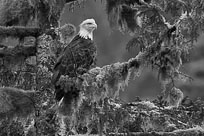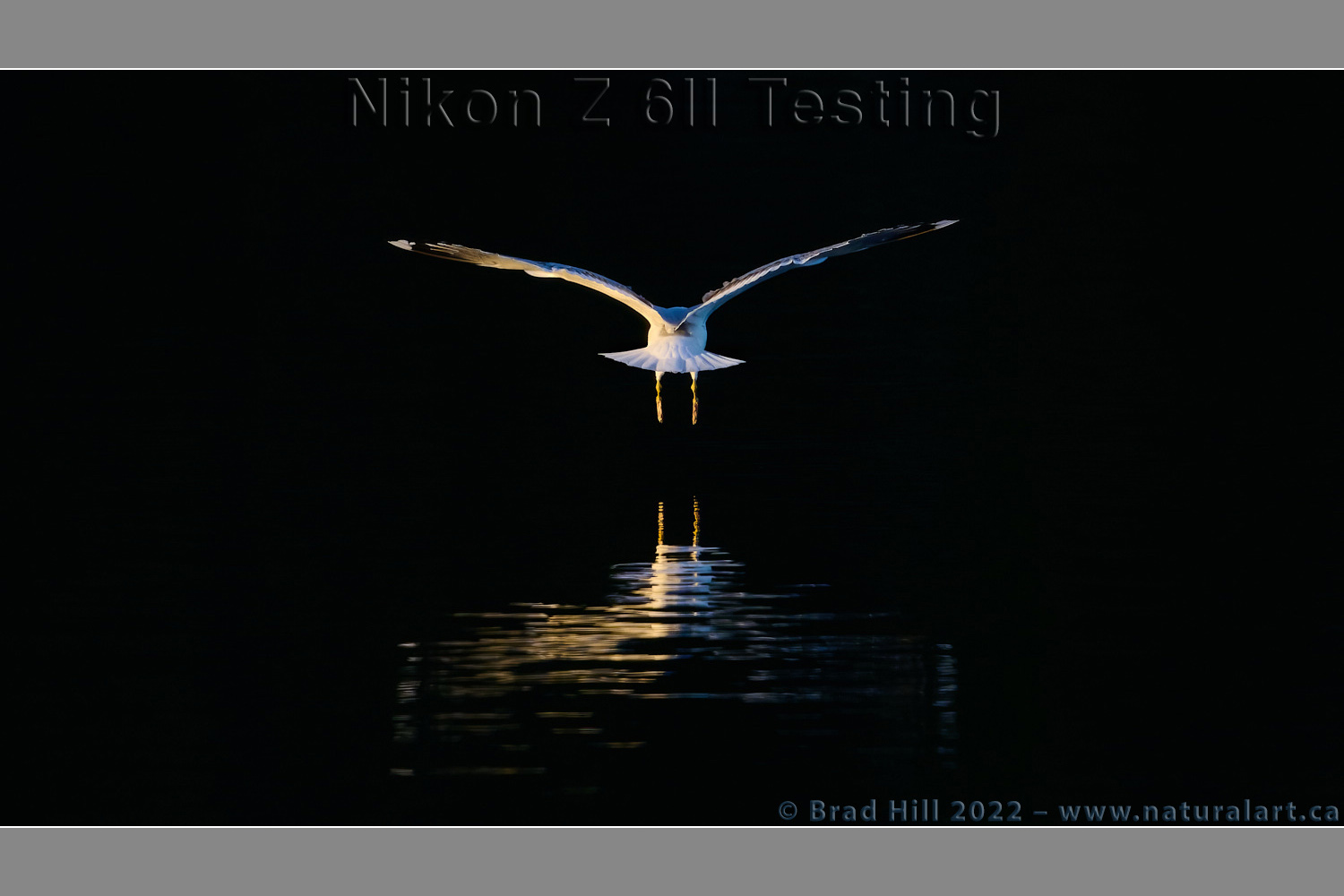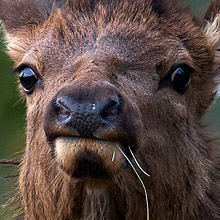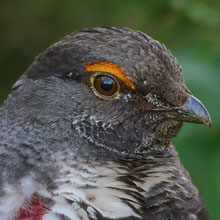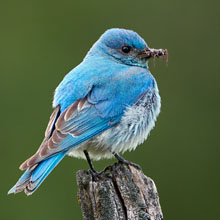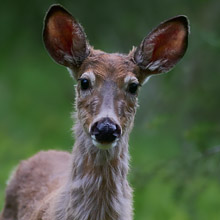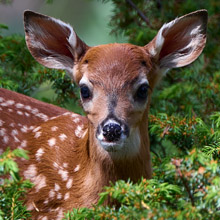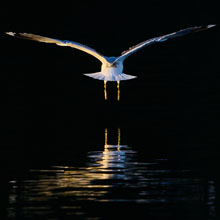Availability: Undetermined - Enquiries?
In the Field
Dancing in Dawn's First Light.. Queen Charlotte Strait (northern Vancouver Island region), BC, Canada. October 18, 2021.
This is my 12th image post outlining my experiences using the Nikon Z 6II in a field setting. I captured this high-contrast image on the last morning of our inaugural Autumn in the Queen Charlotte Strait photo tour in October of 2021. I was on the deck of the boat we were using for the tour (a classic wooden schooner - The Passing Cloud) and watching gulls feeding on the surface of the water just as they were being struck by the first rays of light of the morning. Everything behind the gulls was in the deep shade of a large island, leaving me with striking side-lighting of the subject against inky-black water. It's the kind of lighting I just love!
Two aspects of the image capture merit discussion. First, while many pundits criticize the AF performance of the Nikon Z 6II when it comes to shooting action (I know of no one who ever criticizes the ACCURACY of the AF of the Z 6II), I've had pretty good luck shooting action with it. You won't ever hear me claim it's on equal footing with either the D6 or Z 9 for action shooting, but nor is any other camera in the price range of the Z 6II. I used the Z 6II's Dynamic-area AF area mode on this shot and I can't complain how it worked! ;-)
Second - and although I have mentioned this before on this website - there's a 2-part "secret" I can't shout out enough (and I'd love if it wasn't a secret at all). The first part of the secret is a general statement: it's hard to overstate how much better teleconverters perform (with either F-mount or Z-mount lenses) when shot on a Z-series mirrorless body (compared to when shot on any of Nikon's DSLR's). My educated guess is that it's because of the increased accuracy of the Zed's focusing system (owing to the fact that the focusing takes place on the image sensor rather than a secondary "proxy" sensor).
Part two of the secret is very specific: If you are looking at a reasonably affordable way to get to a focal length of 700mm and still get excellent image quality, nothing beats shooting with the Nikkor 500mm f5.6E PF combined with the TC-14EIII on a Z-body. Despite the maximum aperture of f8 with this lens/TC combination, AF on the full-frame Zed bodies (so currently the Z 6II, Z 7II, and Z 9) works just fine…and you get such sharp, sharp results! While 700mm is on the long end of the focal lengths I use for most of my work, for a lot of bird photographers it's a great, highly useful focal length (and because the 500mm PF is so small and light, it's a really easy lens/TC combination to hand-hold).
I'm very much looking forward to returning to the Queen Charlotte Strait and leading photo tours there (and finding more great photo ops) in 2022 and beyond!
Here's a larger version (2400 pixel) of this eye-catching gull image:
• Dancing in Dawn's First Light: Download 2400 pixel image (JPEG: 0.6 MB)
ADDITIONAL NOTES:
1. This image - in all resolutions - is protected by copyright. I'm fine with personal uses of them (including use as desktop backgrounds or screensavers on your own computer), but unauthorized commercial use of the image is prohibited by law. Thanks in advance for respecting my copyright!
2. Like all photographs on this website, this image was captured following the strict ethical guidelines described in The Wildlife FIRST! Principles of Photographer Conduct. I encourage all wildlife photographers to always put the welfare of their subjects above the value of their photographs.
3. This image was captured during our first annual "Autumn in the Queen Charlotte Strait" photo tour in 2021. Each year we offer trips into two different parts of the Great Bear Rainforest as well as one to photograph aquatic mammals and oceanscapes on the northern and west coasts of Vancouver Island. Details about these trips can be found on the Photo Tours page of this website.
Behind the Camera
Dancing in Dawn's First Light.. Queen Charlotte Strait (northern Vancouver Island region), BC, Canada. October 18, 2021.
Compressed RAW (NEF) 14-bit format; ISO 1000.
Nikon Z 6II paired with Nikkor 500mm f5.6E PF plus TC-14EIII (1.4x) teleconverter (700mm focal length). Hand-held. VR on in Sport mode. Dynamic area AF area mode.
1/1000s @ f8; -3.0 stop compensation from matrix-metered exposure setting.
At the Computer
Dancing in Dawn's First Light.. Queen Charlotte Strait (northern Vancouver Island region), BC, Canada. October 18, 2021.
RAW Conversion to 16-bit PSD file (and JPEG files for web use), including all global and selective adjustments, using Phase One's Capture One Pro 21. Global adjustments on this image were limited to adjustments to highlights and whites. Selective local adjustments performed using Capture One Pro's layers and masking tools. In this case selective adjustments were made on 2 separate layers and included one or more tweaks to saturation and contrast (with a curves adjustment to the tail feathers).
Photoshop modifications were limited to the insertion of the watermark and/or text.
Conservation
Dancing in Dawn's First Light.. Queen Charlotte Strait (northern Vancouver Island region), BC, Canada. October 18, 2021.
Species Status in Canada*: This species is not designated as at risk.
The gull in this high-contrast image could be a Mew Gull (Larus canus), or it could be a Ring-billed Gull (Larus delawarensis), or it could even be a California Gull (Larus californicus). Or it could be somewhere in-between…most of these white-headed, yellow-legged, and moderately-sized gulls hybridize. And, to complicate things even further, some authorities (e.g., birdsoftheworld.org and the American Ornithological Society) even reject that the Mew Gull is a distinct species - they lump it in with the Common Gull (also Larus canus) of the Old World.
But regardless of its actual identity there is good news…none of these species are globally threatened - all are categorized as of "Least Concern" (from a conservation perspective). And all, in the right situation and lighting, can make for great photo subjects!
*as determined by COSEWIC: The Committee on the Status of Endangered Wildlife in Canada










